Upon arrival we immediately left Johannesburg behind us in our Almire Nissan rented for $28 a day, insurance included. We went to Witbank, a small town en route to Kruger Park. (route travelled in SA about 12000km in 52 days >>>>
Kruger Park is still the flagship park of South Africa’s National Parks system. It is roughly half the size of Costa Rica, completely dedicated to the protection of free roaming wildlife, but with accessibility for nature-tourism. Hence, the parks have strict rules about how people behave and we were impressed: most visitors follow the rules such as driving 50km/hr, a major 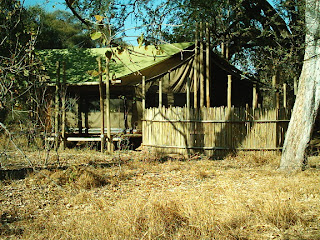 adjustment for South Africans, who outside the parks think nothing of going 150km/hr. Kruger has about 12 camps where people can stay overnight, providing a variety of facilities, from simple camping spots to luxury
adjustment for South Africans, who outside the parks think nothing of going 150km/hr. Kruger has about 12 camps where people can stay overnight, providing a variety of facilities, from simple camping spots to luxury
chalets. The camp areas in Kruger are fenced, to keep the lions, leopards, hyenas and cheetahs out, but in Mapungubwe Park at the Zimbabwe border, the luxury (stove, fridge, full kitchen, hot water) tent camp (>>>)
 adjustment for South Africans, who outside the parks think nothing of going 150km/hr. Kruger has about 12 camps where people can stay overnight, providing a variety of facilities, from simple camping spots to luxury
adjustment for South Africans, who outside the parks think nothing of going 150km/hr. Kruger has about 12 camps where people can stay overnight, providing a variety of facilities, from simple camping spots to luxurychalets. The camp areas in Kruger are fenced, to keep the lions, leopards, hyenas and cheetahs out, but in Mapungubwe Park at the Zimbabwe border, the luxury (stove, fridge, full kitchen, hot water) tent camp (>>>)
has no camp-fence so the meat eaters sometimes come sniffing under the tent, yet, the parks are actually among the safest places to be in South Africa.
The parks are very popular: the week-ends often need to be booked several months ahead and several local people always spend their vacations and holidays in the various parks. In most parks that have the predator species (not all have them) the park policy is to not interfere with the wildlife. Only drinking water is provided for the 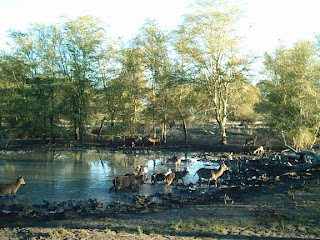 animals at certain intervals (pumped up from boreholes) but not used for irrigation. Thus, droughts may cut down the animal populations when there is a scarcity of vegetation. In the Kgalagadi Park (Kalahari desert), the major camp is named Twee Rivieren (=Two Rivers), but the last time there was water running in the Nossob River was 1963.
animals at certain intervals (pumped up from boreholes) but not used for irrigation. Thus, droughts may cut down the animal populations when there is a scarcity of vegetation. In the Kgalagadi Park (Kalahari desert), the major camp is named Twee Rivieren (=Two Rivers), but the last time there was water running in the Nossob River was 1963.
 animals at certain intervals (pumped up from boreholes) but not used for irrigation. Thus, droughts may cut down the animal populations when there is a scarcity of vegetation. In the Kgalagadi Park (Kalahari desert), the major camp is named Twee Rivieren (=Two Rivers), but the last time there was water running in the Nossob River was 1963.
animals at certain intervals (pumped up from boreholes) but not used for irrigation. Thus, droughts may cut down the animal populations when there is a scarcity of vegetation. In the Kgalagadi Park (Kalahari desert), the major camp is named Twee Rivieren (=Two Rivers), but the last time there was water running in the Nossob River was 1963. The water holes are the place of much animal activity. Usually at dawn and dusk the animals carefully approach the water to drink, trying not to end up as the lion’s meal. Actually, the lionesses are the most dangerous, since they hunt cooperatively. We saw three with their 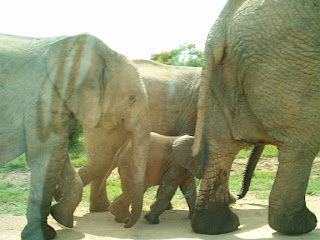 gemsbok kill. Young (inexperienced)and old (loss of ability) males, who tend to hunt individually, are often unsuccessful and die of hunger. The food pyramid dynamics is reflected in the sightings of the animals: impalas and springbok are everywhere in relatively large numbers and form the major feeding base for the carnivores. Elephants usually do not end up as a meal for the carnivores. In the first place because the females tend to stay in close-knit family groups and all females surround the youngest animal for protection.
gemsbok kill. Young (inexperienced)and old (loss of ability) males, who tend to hunt individually, are often unsuccessful and die of hunger. The food pyramid dynamics is reflected in the sightings of the animals: impalas and springbok are everywhere in relatively large numbers and form the major feeding base for the carnivores. Elephants usually do not end up as a meal for the carnivores. In the first place because the females tend to stay in close-knit family groups and all females surround the youngest animal for protection.
Mature male elephants usually are “loners” (or travel with another one or two males at the most) and become so large and powerful that they are actually the undisputed “king” of the animal world. In Kruger Park there are now too many elephants since an earlier culling program was stopped. The traditional danger to Elephants living in parks was poachers; many were killed just for their ivory, while truly wild elephants were hunted down for a large variety of reasons.
travel with another one or two males at the most) and become so large and powerful that they are actually the undisputed “king” of the animal world. In Kruger Park there are now too many elephants since an earlier culling program was stopped. The traditional danger to Elephants living in parks was poachers; many were killed just for their ivory, while truly wild elephants were hunted down for a large variety of reasons.
 gemsbok kill. Young (inexperienced)and old (loss of ability) males, who tend to hunt individually, are often unsuccessful and die of hunger. The food pyramid dynamics is reflected in the sightings of the animals: impalas and springbok are everywhere in relatively large numbers and form the major feeding base for the carnivores. Elephants usually do not end up as a meal for the carnivores. In the first place because the females tend to stay in close-knit family groups and all females surround the youngest animal for protection.
gemsbok kill. Young (inexperienced)and old (loss of ability) males, who tend to hunt individually, are often unsuccessful and die of hunger. The food pyramid dynamics is reflected in the sightings of the animals: impalas and springbok are everywhere in relatively large numbers and form the major feeding base for the carnivores. Elephants usually do not end up as a meal for the carnivores. In the first place because the females tend to stay in close-knit family groups and all females surround the youngest animal for protection.Mature male elephants usually are “loners” (or
 travel with another one or two males at the most) and become so large and powerful that they are actually the undisputed “king” of the animal world. In Kruger Park there are now too many elephants since an earlier culling program was stopped. The traditional danger to Elephants living in parks was poachers; many were killed just for their ivory, while truly wild elephants were hunted down for a large variety of reasons.
travel with another one or two males at the most) and become so large and powerful that they are actually the undisputed “king” of the animal world. In Kruger Park there are now too many elephants since an earlier culling program was stopped. The traditional danger to Elephants living in parks was poachers; many were killed just for their ivory, while truly wild elephants were hunted down for a large variety of reasons.The wildlife parks were started to prevent the total indiscriminate slaughter of the many species that originally inhabited Southern Africa: many species were close to extinction after the Europeans came with their guns. However, it wasn’t always hunting that destroyed the animal population. For example, the West Coast 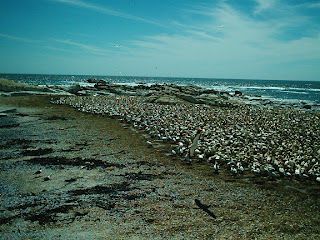 Park is a miniscule park, consisting of a rock where a colony of gannets does their communal pooping. Over the many years this layer of poop had build up very thick and was full of tunnels which had become the preferred place for penguins to hatch their eggs: kind of like a poop condominium for penguins. Thus there was a thriving penguin community associated with the gannets.
Park is a miniscule park, consisting of a rock where a colony of gannets does their communal pooping. Over the many years this layer of poop had build up very thick and was full of tunnels which had become the preferred place for penguins to hatch their eggs: kind of like a poop condominium for penguins. Thus there was a thriving penguin community associated with the gannets.
 Park is a miniscule park, consisting of a rock where a colony of gannets does their communal pooping. Over the many years this layer of poop had build up very thick and was full of tunnels which had become the preferred place for penguins to hatch their eggs: kind of like a poop condominium for penguins. Thus there was a thriving penguin community associated with the gannets.
Park is a miniscule park, consisting of a rock where a colony of gannets does their communal pooping. Over the many years this layer of poop had build up very thick and was full of tunnels which had become the preferred place for penguins to hatch their eggs: kind of like a poop condominium for penguins. Thus there was a thriving penguin community associated with the gannets. Until an enterprising Brit found that there was a market for manure and organized “guano” expeditions, carrying shiploads of shit back to 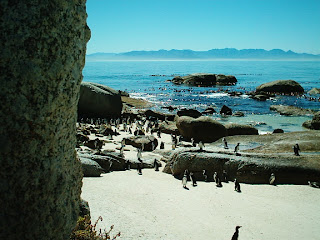
Britain. Workers (guano diggers) for that enterprise were often obtained from the bars of Cape Town, that is, the drunks were rounded up at night and woke up the next day, finding themselves prisoners on board the guano ships. All the guano was taken, scraped barren to the rock again. The gannets are still standing wing to wing doing their communal concentrated pooping, but the penguin population is reduced to a miserable few since the layer of poop is to thin for tunnels. However, at Boulders Park the penguin population is flourishing because the park provides and maintains the proper environment for the hatching of eggs: dense low bushes near the waterfront, right next to the condominiums of humans who can sit on their balconies and observe the frolicking Right Whales in False Bay. The whale population has finally increased again after almost being
Cape Town, that is, the drunks were rounded up at night and woke up the next day, finding themselves prisoners on board the guano ships. All the guano was taken, scraped barren to the rock again. The gannets are still standing wing to wing doing their communal concentrated pooping, but the penguin population is reduced to a miserable few since the layer of poop is to thin for tunnels. However, at Boulders Park the penguin population is flourishing because the park provides and maintains the proper environment for the hatching of eggs: dense low bushes near the waterfront, right next to the condominiums of humans who can sit on their balconies and observe the frolicking Right Whales in False Bay. The whale population has finally increased again after almost being 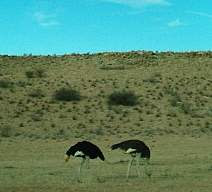 wiped out in the 50’s and 60’s. Many whales can be seen in various bays along the southern coast. Unfortunately they are not as eager to pose for pictures as the birds and land animals, but the many explanatory signs put out by the government assure the reader that they can grow to be as big as 10 elephants put together. As Nelson Mandela said, we are proud to have our parks where you can see the largest land animal, the largest sea animal and the largest flightless bird (ostrich >>>)
wiped out in the 50’s and 60’s. Many whales can be seen in various bays along the southern coast. Unfortunately they are not as eager to pose for pictures as the birds and land animals, but the many explanatory signs put out by the government assure the reader that they can grow to be as big as 10 elephants put together. As Nelson Mandela said, we are proud to have our parks where you can see the largest land animal, the largest sea animal and the largest flightless bird (ostrich >>>)
Britain. Workers (guano diggers) for that enterprise were often obtained from the bars of
 Cape Town, that is, the drunks were rounded up at night and woke up the next day, finding themselves prisoners on board the guano ships. All the guano was taken, scraped barren to the rock again. The gannets are still standing wing to wing doing their communal concentrated pooping, but the penguin population is reduced to a miserable few since the layer of poop is to thin for tunnels. However, at Boulders Park the penguin population is flourishing because the park provides and maintains the proper environment for the hatching of eggs: dense low bushes near the waterfront, right next to the condominiums of humans who can sit on their balconies and observe the frolicking Right Whales in False Bay. The whale population has finally increased again after almost being
Cape Town, that is, the drunks were rounded up at night and woke up the next day, finding themselves prisoners on board the guano ships. All the guano was taken, scraped barren to the rock again. The gannets are still standing wing to wing doing their communal concentrated pooping, but the penguin population is reduced to a miserable few since the layer of poop is to thin for tunnels. However, at Boulders Park the penguin population is flourishing because the park provides and maintains the proper environment for the hatching of eggs: dense low bushes near the waterfront, right next to the condominiums of humans who can sit on their balconies and observe the frolicking Right Whales in False Bay. The whale population has finally increased again after almost being  wiped out in the 50’s and 60’s. Many whales can be seen in various bays along the southern coast. Unfortunately they are not as eager to pose for pictures as the birds and land animals, but the many explanatory signs put out by the government assure the reader that they can grow to be as big as 10 elephants put together. As Nelson Mandela said, we are proud to have our parks where you can see the largest land animal, the largest sea animal and the largest flightless bird (ostrich >>>)
wiped out in the 50’s and 60’s. Many whales can be seen in various bays along the southern coast. Unfortunately they are not as eager to pose for pictures as the birds and land animals, but the many explanatory signs put out by the government assure the reader that they can grow to be as big as 10 elephants put together. As Nelson Mandela said, we are proud to have our parks where you can see the largest land animal, the largest sea animal and the largest flightless bird (ostrich >>>)and the largest bird that can fly (secretary bird).
It is hard to realize that the wild animals easily outnumbered people before the 1830's. That was the period when several Boer families decided to flee the domination of the English in the Cape Colony. This ignited a whole series of battles between the existing Black tribes and the Boers. This was 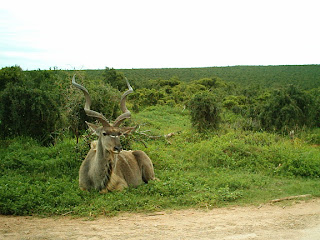 followed by the English defeating the Boers and annexing the Boer Republics into English colonies again, mainly to ensure the ownership and control of the many mineral resources (gold, diamonds, coal, copper, platinum, chromium) that were discovered in the Boer Republics of Orange Free State, Transvaal and Natal.
followed by the English defeating the Boers and annexing the Boer Republics into English colonies again, mainly to ensure the ownership and control of the many mineral resources (gold, diamonds, coal, copper, platinum, chromium) that were discovered in the Boer Republics of Orange Free State, Transvaal and Natal.
Today almost all South Africans agree Nelson Mendela has been the major reason that racial hates have not gone like in some of the countries to the north. But much remains to be worked out. The seperation between blacks, coloureds and whites is still sharp, as is the difference between poor and rich.
Human populations traditionally were sm all, since much of inland South Africa is semi or full desert, with extreme weather differences and only the herding of animals made it feasible for humans to survive the harsh climate. To the traveller, South Africa still seems very "empty" with huge distances between small villages.
all, since much of inland South Africa is semi or full desert, with extreme weather differences and only the herding of animals made it feasible for humans to survive the harsh climate. To the traveller, South Africa still seems very "empty" with huge distances between small villages.
 all, since much of inland South Africa is semi or full desert, with extreme weather differences and only the herding of animals made it feasible for humans to survive the harsh climate. To the traveller, South Africa still seems very "empty" with huge distances between small villages.
all, since much of inland South Africa is semi or full desert, with extreme weather differences and only the herding of animals made it feasible for humans to survive the harsh climate. To the traveller, South Africa still seems very "empty" with huge distances between small villages.Many farmers have switched away from traditional herding species to the keeping of
"game farms" offering tourist related activities, including hunting, so that the tourists can shoot their own animal and have them prepared by a taxidermist (we stayed in a B&B in Klerksdorp owned by a taxidermist who gave us a full tour of his operation).
In certain districts heavy capital investments in irrigation systems have made crop production possible, such as along the Orange and Olifants Rivers (near Klawer)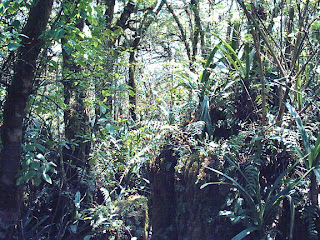

There are areas where rainfall does occur, particularly in KwaZulu-Natal and the high Drakensberg area near Graskop. Near God's Window (name of a viewpoint) there is even a small high altitude rainforest, (>>>>)
due to the large differences in temperature that frequently cause dense fogs or thunder showers. These areas ( and where rainfall is relatively regular) are today planted with immense tree farms, mostly with trees that can handle draught conditions such as the eucalyptus. In what is now the St Lucia Wetland park on the east coast, the densely planted trees were actually drying up the largest natural inland Lake of South Africa. So 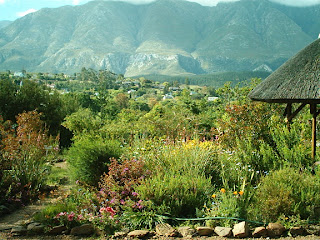 the tree farming was stopped and the land was nurtured back to the original native brush species, saving the lake. and the many bird species that depended on it.
the tree farming was stopped and the land was nurtured back to the original native brush species, saving the lake. and the many bird species that depended on it.
Near the town of Springbok, at the Goegab Nature Reserve, the female manager of the park was able to spend some time with us showing the immense variety of plants in the local desert when it is not destroyed by overgrazing. Nature reserves are not part of the National Park 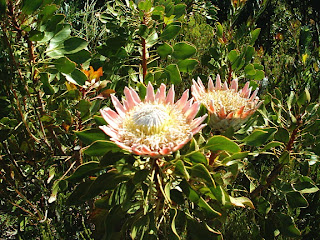 system and depend on government funding since they are not geared to the tourist trade like the parks.
system and depend on government funding since they are not geared to the tourist trade like the parks.
To appreciate the uniqueness and beauty of the South African vegetation a visit to Kirstenbosch (the botanical garden of Cape Town) is certainly recommended. Another district with immense beauty is the grape growing district of Stellenbosch, Paarl and Franschhoek. The production of excellent affordable wines is 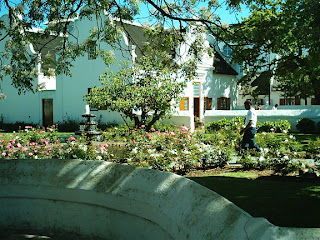 booming, thanks to the removal of former boycotts that existed on products during the apartheid period. Franschhoek was where the Huguenots settled and the town is still a French enclave in an Afrikaaner world. This is also the district where the best of the "Cape Colonial" style housing is best preserved and where the oak trees are flourishing.
booming, thanks to the removal of former boycotts that existed on products during the apartheid period. Franschhoek was where the Huguenots settled and the town is still a French enclave in an Afrikaaner world. This is also the district where the best of the "Cape Colonial" style housing is best preserved and where the oak trees are flourishing.
 booming, thanks to the removal of former boycotts that existed on products during the apartheid period. Franschhoek was where the Huguenots settled and the town is still a French enclave in an Afrikaaner world. This is also the district where the best of the "Cape Colonial" style housing is best preserved and where the oak trees are flourishing.
booming, thanks to the removal of former boycotts that existed on products during the apartheid period. Franschhoek was where the Huguenots settled and the town is still a French enclave in an Afrikaaner world. This is also the district where the best of the "Cape Colonial" style housing is best preserved and where the oak trees are flourishing.In Swaziland the wildlife parks are aligned with the South African National Parks (while the Natal parks are not!!). These parks (and the animals) are fully "owned" by the king (to scare off poachers), who just recently married his 14th wife. We stayed in two parks, one in the mountains in a rainy zone, where the grazing was very lush, the other in a dry "veld" zone 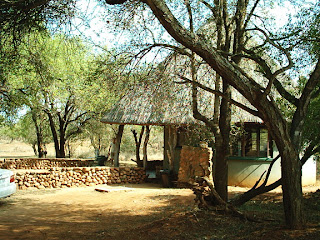 where it had not rained for many years and the animals were under great stress and the lions had been placed in a special compound (partly because the area covered by the park is too small to provide alternative grazing) Yet, directly north of the park the Swaziland sugar cane crops were flourishing due to the extensive irrigation system, also "owned" by the king.
where it had not rained for many years and the animals were under great stress and the lions had been placed in a special compound (partly because the area covered by the park is too small to provide alternative grazing) Yet, directly north of the park the Swaziland sugar cane crops were flourishing due to the extensive irrigation system, also "owned" by the king.
 where it had not rained for many years and the animals were under great stress and the lions had been placed in a special compound (partly because the area covered by the park is too small to provide alternative grazing) Yet, directly north of the park the Swaziland sugar cane crops were flourishing due to the extensive irrigation system, also "owned" by the king.
where it had not rained for many years and the animals were under great stress and the lions had been placed in a special compound (partly because the area covered by the park is too small to provide alternative grazing) Yet, directly north of the park the Swaziland sugar cane crops were flourishing due to the extensive irrigation system, also "owned" by the king. Independent travel can be done safely, although it does require "listening carefully"to the advice of the local people, reading the newspaper and to obey signs. We saw traffic signs warning "Hyjack Area" or "No stopping for your own safety". The stealing of cars is an ongoing epidemic, so one always evaluates the safety of parking in the places where one stays. The rule of thumb we found: the larger the city, the higher is the potential danger. Always use the ATM machine inside the gas stations (SA gas stations do not accept regular credit cards: only cash or special Petrol Cards) Cost of gas $1 per liter.
Self catering apartments and B&B's are plentiful, mostly excellent, yet easy on the pocketbook. Shopping malls with "everything" are everywhere, but in the smaller towns Sunday closures are very common. No wine or beer are sold on Sunday in stores that are open on that day. In the larger National parks there are stores, gas stations and restaurants, but luckily no advertising signs, tv, computer connections or MacDonalds.
In Cape Town we were able to renew (since 52 years) the contact with the Lamers branch of their world-wide network. We happily did some wine testing together and found it more then satisfactory.
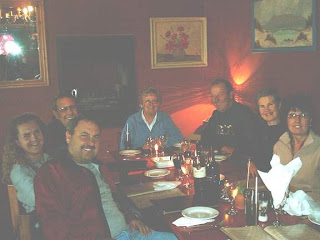
1 comment:
Great blog. Do we have permission to use some (or all) of the info for our SA trip in 2008 or 09?
This is so much easier than having to read a whole book!!!!
Sounds like you had a great time.
Post a Comment